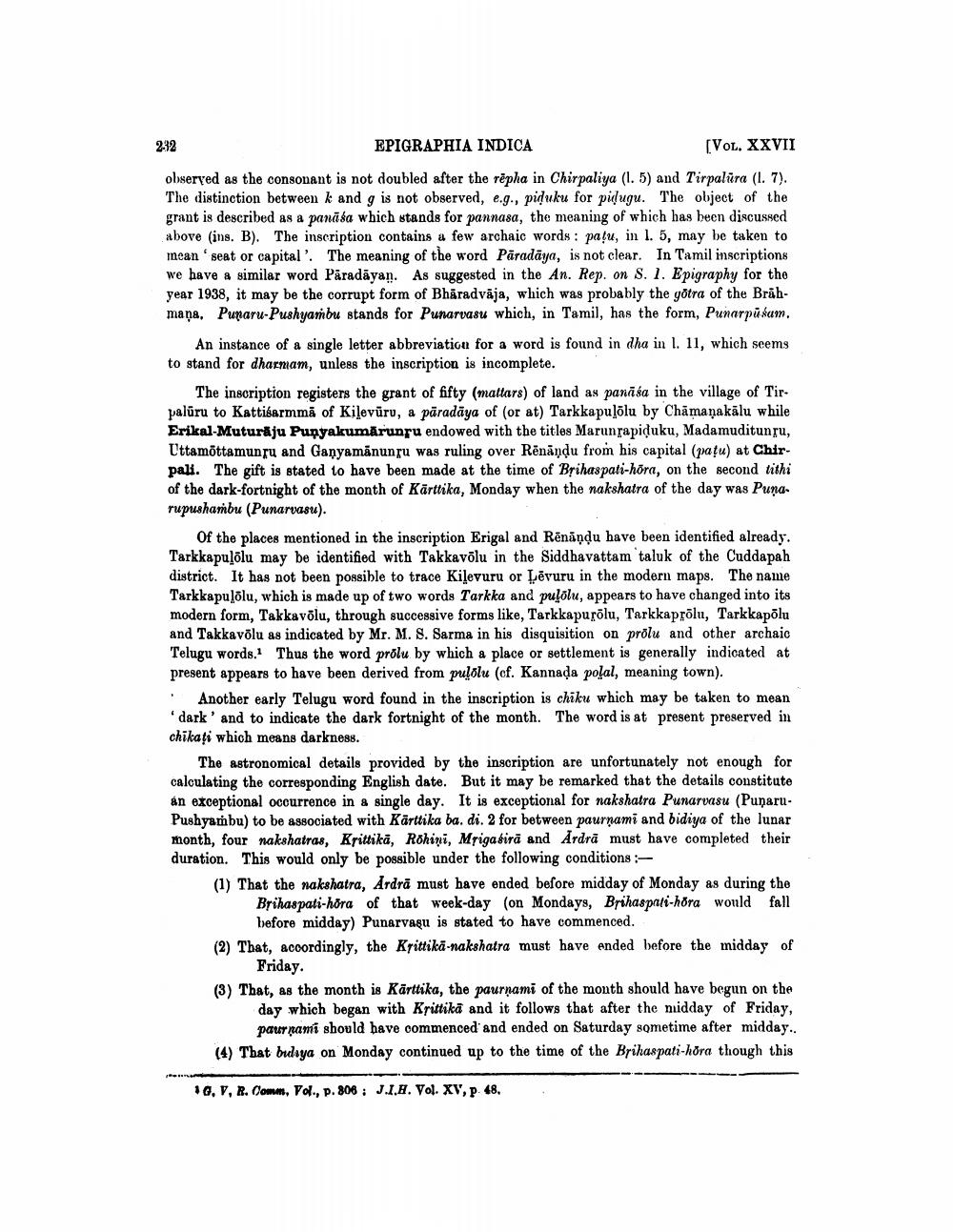________________
232 EPIGRAPHIA INDICA
[VOL. XXVII observed as the consonant is not doubled after the rëpha in Chirpaliya (1. 5) and Tirpalūra (1. 7). The distinction between k and g is not observed, e.g., piduku for pidugu. The object of the grant is described as a panāda which stands for pannasa, the meaning of which has been discussed above (ins. B). The inscription contains a few archaic words: paļu, in l. 5, may be taken to mean' seat or capital'. The meaning of the word Pāradāya, is not clear. In Tamil inscriptions we have a similar word Paradāyan. As suggested in the An. Rep. on S. 1. Epigraphy for the year 1938, it may be the corrupt form of Bhāradvāja, which was probably the yötra of the Brāhmaņa. Punaru-Pushyambu stands for Punarvasu which, in Tamil, has the form, Punarpūšam.
An instance of a single letter abbreviation for a word is found in dha in l. 11, which seems to stand for dharmam, unless the inscription is incomplete.
The inscription registers the grant of fifty (mattars) of land as panāsa in the village of Tir. palūru to Kattišarmmā of Kiļevūru, a pāradāya of (or at) Tarkkapulālu by Chāmaņakālu while Erikal-Muturaju Punyakumārunru endowed with the titles Marunrapiduku, Madamuditungu, Uttamöttamunyu and Ganyamánunru was ruling over Rënāvdu from his capital (pațu) at Chirpali. The gift is stated to have been made at the time of Brihaspati-höra, on the second tithi of the dark-fortnight of the month of Kārttika, Monday when the nakshatra of the day was Puna. rupushambu (Punarvasu).
Of the places mentioned in the inscription Erigal and Rënându have been identified already. Tarkkapulõlu may be identified with Takkavõlu in the Siddhavattam taluk of the Cuddapah district. It has not been possible to trace Kilevuru or Lēvuru in the modern maps. The name Tarkkapulolu, which is made up of two words Tarkka and pulolu, appears to have changed into its modern form, Takkavõlu, through successive forms like, Tarkkapurõlu, Tarkkaprõlu, Tarkkapõlu and Takkavõlu as indicated by Mr. M. S. Sarma in his disquisition on prölu and other archaic Telugu words. Thus the word prolu by which a place or settlement is generally indicated at present appears to have been derived from pulolu (cf. Kannada polal, meaning town).
Another early Telugu word found in the inscription is chiku which may be taken to mean dark' and to indicate the dark fortnight of the month. The word is at present preserved in chikati which means darkness.
The astronomical details provided by the inscription are unfortunately not enough for calculating the corresponding English date. But it may be remarked that the details constitute an exceptional occurrence in a single day. It is exceptional for nakshatra Punarvisu (PunaruPushyambu) to be associated with Kärttika ba. di. 2 for between paurnami and bidiya of the lunar month, four nakshatras, Krittika, Rohini, Mrigasira and Ardrā must have completed their duration. This would only be possible under the following conditions: (1) That the nakshatra, Ardrä must have ended before midday of Monday as during the
Brihaspati-höra of that week-day (on Mondays, Brihaspati-höra would fall
before midday) Punarvasu is stated to have commenced. (2) That, accordingly, the Kittikä nakshatra must have ended before the midday of
Friday. (3) That, as the month is Kärttika, the paurnami of the month should have begun on the
day which began with Krittikā and it follows that after the nidday of Friday,
paurnami should have commenced and ended on Saturday sometime after midday.. (4) That budaya on Monday continued up to the time of the Brihaspati-höra though this
"Q, V, R. Comm. Vol., p. 808 ; J.I.H. Vol. XV, p. 48.




